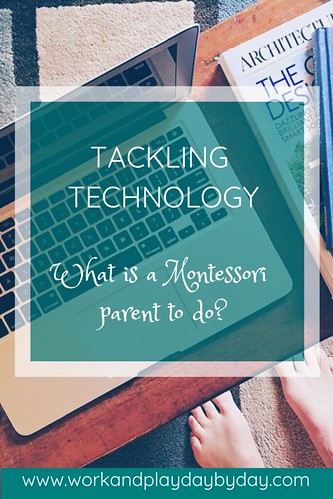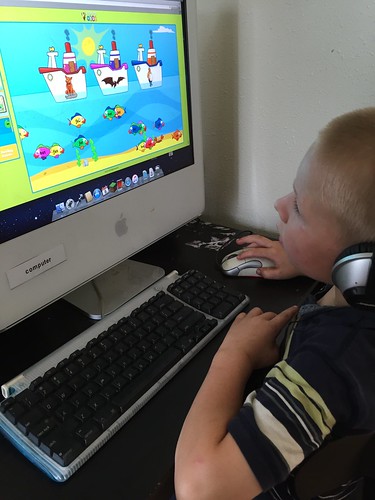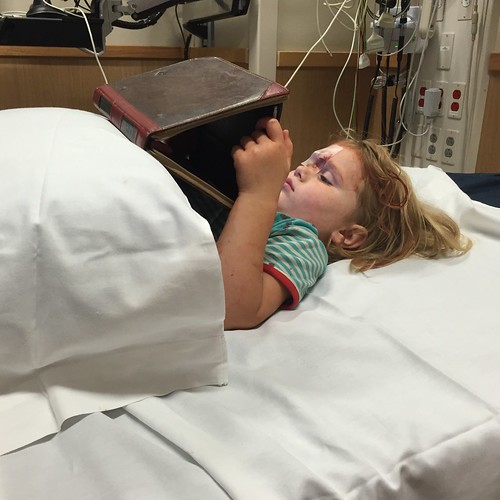
Ask any a group of parents in the year 2017 how they handle technology in their home and you will undoubtedly hear passionate responses from a variety of extremes. I know families who have no computers or internet connections in their home and families who have all the latest technology with unlimited restrictions. Both can offer perfectly logical and understandable rationale for their decisions. In reality, I could say that much and stop this post right there. Make an intentional decision you feel is right based on your family’s circumstances and go from there.
Note: You may notice I don’t have much in terms of pictures for this post. That’s because I don’t believe in staging pictures for my blog unless its for a specific new product and because I take pictures of things that are interesting and memorable…. My kids with their faces glued to screens doesn’t meet my definition of either interesting or memorable!
I have had the opportunity to spend time in several Montessori schools. My observations there give me some solid clues about how the Montessori experts have addressed this issue based on their knowledge and experience of the planes of development.
The first thing I notice is that there is seldom any technology in the Children’s House (3-6) and little to none in the Elementary I level (6-9). This jives very well with the psychological need for the concrete during this period of development. It also jives well with the brain based research on the effects of technology on developing brains. The AAP has continually further restricted technology recommendations for the lower age ranges, even while developers look to exploit uses claiming the recommendations are outdated and unrealistic. At the same time, the traditional educational system is lining up for iPads for kindergarteners and computers in preschools and kids are turning themselves into fake YouTube stars long before they understand its just a game. Once again proving, that what Maria Montessori observed and intuited would is good for kids (concrete before abstract) is backed up by research and that traditional education models care very little for either.
But that’s a different soapbox…
In choosing curriculum supplements for my younger children I try to keep this in mind. I try to stay away from relying on any technology-based applications as the foundation of their curriculum. I have some Montessori apps (mostly various puzzles) on my iPad, which I bring along for appointments if we are going to have a long day but we don’t use them on a daily basis. The only semi-regular exception I make is for a reading supplement, such as what Logan is doing here with Reading Eggs, with kids who have been slow to respond to the materials and need extra fluency practice. Even in that case, however, it is the second line of defense and only used with additional materials instruction and practice as well.
In my experience, moving towards the upper Elementary (9-12) and ErdKinder (Middle School/High School) years, technology starts to appear in Montessori classrooms in fairly significant ways. The keys about how this technology is used is that it is first used for research. This is both practical and functional. No one can go to the library and dig through a card catalog any longer as many have long completely done away with them. Research is a cornerstone of the elementary curriculum and it makes practical sense for students to learn to do this in the way they will continue to do so as they grow. Typing is a relevant practical life skill.
I’ve seen some extremely modern technology set ups in ErdKinder settings and I think this is very appropriate. In most cases, the students are using the technology as a supplement to their knowledge (research) and for innovation and problem solving applications. Often it is not the teachers using the devices, rather the students using them in ways that they have developed on their own as a means of expanding or demonstrating their knowledge. With my older kids educationally, this is our litmus test of technology use. I do use Math U See videos (yes- even in 2017 this counts as technology use) once we reach a certain point and have the kids type their papers.
Free Time & Freedom Within Limits
In my opinion, the answer to the question of if technology should be used in the classroom is simple: No if they are little, yes if they are big and it expands or demonstrates knowledge and skills. What about other uses though?
Two of my kids have their own Kindles, both of which they purchased with their own money. I think this is a pretty key indicator that they were ready to handle the responsibility of managing their own device (with support), but that that being said it hasn’t been a flawless adjustment around our house. We’ve used a variety of systems and rules and almost all of them have fallen short of what we really aim for…teaching them good habits for using their own devices responsibly. It’s the whole intrinsic/extrinsic motivation thing.
Knowing the education research about screens and the brain and feeling pulled to natural world play ourselves, we have chosen to keep all of our kids at or below AAP screen time recommendations. Our younger kids are way below as they only get the occasional uses listed above, family movies (maybe once/week), and maybe a little PBS kids time if are sick. We put free time limits on individual devices and keep family devices (TV, computer, etc) password protected to require permission. It isn’t that we don’t grant permission, we just want to make sure we are keeping an eye on who is doing what…when and where.
Within that, however, we let the kids choose which books, games, movies, etc. they interact with based on conversations about age appropriateness with each individual child and situation. We let them decide (for the most part) when they will use the time that has been allotted to them, with the expectation that it not interfere with their other responsibilities. When it interferes with responsibilities or results in missed opportunities for fun we make sure to point that out as the natural consequence of their choice to prioritize technology in a given situation.
For the record, this isn’t always easy to do, particularly if they choose to use their time in the karate or dance waiting area and other “naturally minded” parents are watching them (and me) with the look in their eyes that I’m letting my children rot away in front of screens. I’m (slowly) learning not to care, but sometimes I have to swallow my own pride on the matter and remind myself that we’ve made the choices we’ve made for a very good reason and that other parents are free to make other choices.
The Wisdom of Mandated Screen Free Time
As we have navigated the technology route in our home, one thing that we noticed is that with unlimited choice within the established limits it was easy for kids to fall into the habit of constantly checking in with their device. Just to add one more thing to a Minecraft world or see if the standings have changed in their virtual football league. Don’t we as adults get sucked into the same trap of taking five minutes here and there to check our Facebook or email…and five minutes turns into thirty? I suspect I’m not the only one who struggles with that. Even limiting our kids time to 60-90 minutes/day can still result in the impression of always having faces in screens. Nothing is more frustrating than feeling like your kids are on their device every time you need their attention! (Again- ahem, moms!)
In addition to turning off devices a certain amount of time before bed and not allowing usage during school or chore time, we have a set two hours every afternoon that is completely quiet and screen free. Books, crafts, puzzles, quiet school work…anything except screens. Once we instituted this screen free time, the screen “checking in” improved quite a bit. I suspect (and I really am just guessing) this is simply a result of removing the opportunity to develop the habit of checking in every time they had a free minute. I also notice that they are using their screen time for more creative purposes. Just this morning, they were filming the scene from Harry Potter and the Sorcerer’s Stone with the potions. It has distressed them for many years that this brilliant display of Hermione’s contribution and greatest strength was not included in the film version so they have set about to remedy the problem.
Oh, and by the way…. I hold Tim and I to the screen free quiet time as well. No sitting on our phones while the children are occupied in quiet activities. Knitting, reading, playing cards…it’s helping us break our bad habits as well!
A Note on Safety & Technology
Before I close, I want to say a word about the dangers of the internet. The risks of kids (and adults!) being online are very real. Cyber bullying, personal safety, and pornography are legitimate and real threats to modern kids. A few months ago I posted a picture on Instagram where I referred to my girls (Siena and Kenna) and a teen from our church approach Aidan asking him if I was pregnant. My kids know that I use social media even though they aren’t yet allowed to, so Aidan asked follow up questions about what and where he saw this. He verified that it was my account and just kind of let the situation diffuse. When Aidan got home, he asked me right away about it and we went back together through my IG posts and figured out what post this boy saw and how it was misinterpreted. I didn’t even have to say, “This is why you don’t have a {Facebook, instagram, twitter, snapchat, etc} account.” After we finished talking, Aidan turned to me and said it seemed really weird that his friends were looking at my stuff and he probably didn’t need to be online if thats what they were doing.
I firmly believe that kids need to be taught to wrestle with the internet, with or without social media, before they leave home for college. The risks to their personhood, body and soul, however are very real and it is our responsibility as parents to protect them from as much as possible as is age appropriate. When our boys bought their own Kindles, Tim installed the Screen Time application onto both of their devices and both of our phones. They do not have access to web-based applications or browsing and require a password from mom or dad for 100% of downloaded items, even free. We can also see what they are doing in real time and use the app to restrict usage during chore and school times or overnight. The application is available for both Kindle and Apple devices, although the specific features vary based on the platform.
A couple other added layers of safety: (1) internet filters and passwords on every computer and device (even the adults and don’t forget things like Apple TV, WII, and other devices that have apps for site like YouTube); (2) keep internet usage out of private spaces such as bedrooms; (3) keep track of all of your child’s passwords as long as is appropriate and be friends with them long past when its not; and (4) share iTunes and/or Amazon accounts with your child. If you have PG-13 movies you don’t want your child to have access too, you can always add a filter to their individual device.
I think as in many things, the best defense is still a good offense and the best offense is a good defense. Making sure that your child is rooted in reality (people online are real too!), has authentic communication skills, and can think critically will go a long way in keeping them safe online.
Be smart, be aware, and be prayerful and you will hopefully be able to navigate whatever arises with your child individually!
Resources






What a wonderful post. I really agree with you, limiting screen time for kids and us adults is so, so very important!!! While I realize every parent has the right to choose how their kids spend their free time, it makes me sad when I hear so many parents now a days using devices as babysitters even for very little ones. It is amazing how these devices just suck the kids right in and they don't even realize what is going on in the world around them. I would much rather my kids play, get outside, and use their imaginations.
Security is also something so many parents don't realize they need, it is really scary what is out there just looking for kids. My daughter is 18 and still doesn't have a Facebook or many of the other social medias. Despite the fact that she does have her own cell phone that she pays for monthly she feels they are a waste of time. Since we have helped her to make good technology choices growing up she instead spends her time learning different languages, playing word, and vocabulary games.